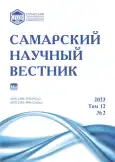Carbon stocks in the litter of the middle taiga deciduous forests of the Komi Republic
- Authors: Pristova T.A.1
-
Affiliations:
- Institute of Biology of Komi Scientific Centre of the Ural Branch of the Russian Academy of Sciences
- Issue: Vol 12, No 2 (2023)
- Pages: 81-85
- Section: Biological Sciences
- URL: https://journals.rcsi.science/2309-4370/article/view/253024
- DOI: https://doi.org/10.55355/snv2023122112
- ID: 253024
Cite item
Full Text
Abstract
Data are presented on the stock and content of carbon in the litter-fall and litter of middle-taiga deciduous forests of different ages, which are formed at the site of felling of bilberry-type spruce forests. It has been determined that the litter of birch-spruce young stands accumulates 10 tC/ha, while annually with ground litter 1 tC/ha enters, in aspen-birch stands – 8 and 2 tC/ha, respectively. The results of the research have shown that the contribution of the litter of the underground part of vegetation to the accumulation of carbon in the litter is comparable to the above-ground one and is about 1 tC/ha per year for woody plants and 0,6–1,1 tC/ha per year for ground cover plants. The rate of annual carbon release in the process of litter destruction is 21–30%, for the fall of assimilating organs of trees and plants of the ground cover – 42–79%, for branches, cones and tree roots – 7–24%. The carbon content in the litter is differentiated by subhorizons: its concentration in Oi is higher than in Oe + Oa. In the studied deciduous stands, the increase in litter reserves from the upper subhorizon to the lower subhorizon is inversely proportional to carbon accumulation. The average annual rate of carbon turnover in the litters is about 3 years.
Full Text
##article.viewOnOriginalSite##About the authors
Tatiana A. Pristova
Institute of Biology of Komi Scientific Centre of the Ural Branch of the Russian Academy of Sciences
Author for correspondence.
Email: pristova@ib.komisc.ru
candidate of biological sciences, researcher of Forest Biology Problems of the North Department
Russian Federation, SyktyvkarReferences
- Aerts R. Climate, leaf litter chemistry and leaf litter decomposition in terrestrial ecosystems: a triangular relationship // Oikos. 1997. Vol. 79, № 2. P. 439–449. doi: 10.2307/3546886.
- Couteaux M.-M., Bottner P., Berg B. Litter decomposition, climate and litter quality // Trends in Ecology & Evolution. 1995. Vol. 10, iss. 2. P. 63–66. DOI: 10.1016/ s0169-5347(00)88978-8.
- Бобкова К.С., Кузнецов М.А. Бюджет углерода в экосистемах среднетаёжных коренных ельников // Журнал общей биологии. 2022. Т. 83, № 6. С. 434–449.
- Бобкова К.С., Машика А.В., Смагин А.В. Динамика содержания углерода органического вещества в среднетаёжных ельниках на автоморфных почвах. СПб.: Наука, 2014. 270 с.
- Лиханова Н.В., Бобкова К.С. Пулы и потоки углерода в экосистемах вырубки ельников средней тайги Республики Коми // Теоретическая и прикладная экология. 2019. № 2. С. 91–100. doi: 10.25750/1995-4301-2019-2-091-100.
- Osipov A.F., Tuzhilkina V.V., Dymov A.A., Bobkova K.S. Phytomass and organic carbon stocks in the Middle Taiga spruce forests during restoration after clear cutting // Biology Bulletin. 2019. Vol. 46, № 2. P. 210–218. doi: 10.1134/s1062359019020109.
- Ефремова Т.Т., Ефремов С.П., Аврова А.Ф. Строение и пространственно-временная изменчивость накопления подстилки в болотных березняках Западной Сибири // Вестник Томского государственного университета. Биология. 2009. № 2 (6). С. 84–94.
- Солодовников А.Н. Показатели плодородия почв под лиственными и хвойными лесами в среднетаёжной подзоне Северо-Запада России [Электронный ресурс] // Современные проблемы науки и образования. 2015. № 6. https://science-education.ru/ru/article/view?id=23221.
- Flanagan P.W., Van Cleve K. Nutrients cycling in relation to decomposition and organic matter quality in taiga ecosystems // Canadian Journal of Forest Research. 1983. Vol. 13, № 5. P. 795–817. doi: 10.1139/x83-110.
- Пристова Т.А. Фитомасса древесных растений в лиственных фитоценозах послерубочного происхождения // Лесной вестник. Forestry Bulletin. 2020. Т. 24, № 1. С. 5–13. doi: 10.18698/2542-1468-2020-1-5-13.
- Пристова Т.А. Фитомасса подлеска в производных лиственных насаждениях средней тайги // Лесотехнический журнал. 2020. Т. 10, № 1 (37). С. 60–68. doi: 10.34220/issn.2222-7962/2020.1/6.
- Пристова Т.А. Динамика надземной фитомассы живого напочвенного покрова в лиственных фитоценозах послерубочного происхождения // Известия Самарского научного центра Российской академии наук. 2019. Т. 21, № 2 (2). С. 204–209.
- World reference base for soil resources. International soil classification system for naming soils and creating legends for soil maps. Rome: FAO, 2015. 181 p.
- Родин Л.Е., Ремезов Н.П., Базилевич Н.И. Методические указания к изучению динамики и биологического круговорота в фитоценозах. Л.: Наука. Ленингр. отд-ние, 1967. 143 с.
- Kochy M., Wilson S.D. Litter decomposition and nitrogen dynamics in aspen forest and mixed-grass prairie // Ecology. 1997. Vol. 78, iss. 3. P. 732–739. DOI: 10.1890/ 0012-9658(1997)078[0732:ldandi]2.0.co;2.
- Германова Н.И., Медведева М.В., Мамай А.В. Динамика разложения листового опада в среднетаёжных насаждениях Карелии // Известия высших учебных заведений. Лесной журнал. 2012. № 1 (325). С. 24–32.
- Пристова Т.А. Скорость разложения растительного опада в лиственных насаждениях послерубочного происхождения в условиях средней тайги Республики Коми // Труды Санкт-Петербургского научно-исследовательского института лесного хозяйства. 2020. № 3. С. 62–72.
- Cartner T.B., Cardon Z.G. Decomposition dynamics in mixed-species leaf litter // Oikos. 2004. Vol. 104, iss. 2. P. 230–246.
- Добровольский Г.В., Трофимов С.Я., Дорофеева Е.И., Лузиков А.В., Гей К.А. Скорость разложения лесных подстилок южнотаёжных ельников // Лесоведение. 1999. № 1. С. 3–9.
- Berg B., Staaf H. Release of nutrients from decomposing white birch leaves and Scots pine needle litter // Pedobiologia. 1987. № 30 (1). P. 55–63. doi: 10.1007/bf02187367.
- Ruess R.W., Van Cleve K., Yarie J., Viereck L.A. Contributions of fine root production and turnover to the carbon and nitrogen cycling in taiga forests of the Alaskan interior // Canadian Journal of Forest Research. 1996. Vol. 26, № 8. P. 1326–1336. doi: 10.1139/x26-148.
- Kurtz W.A., Beukema S.J., Apps M.J. Estimation of root biomass and dynamics for the carbon budget model of the Canadian forest sector // Canadian Journal of Forest Research. 1996. Vol. 26, № 11. P. 1973–1979. DOI: 10.1139/ x26-223.
Supplementary files







